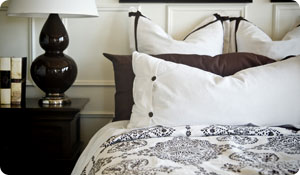
Many factors affect your quality of sleep. The state of the room you sleep in is one of them.
Creating the right environment is essential for getting a good night's sleep. Lighting, room temperature, noise level, air quality and your choice of bedding all contribute to slumber quality. Adjust them to suit your own personal comfort level, and you'll enjoy a more blissful state of slumber.
Sound Off
If you cannot control bothersome noise from outside or from another room in the house, invest in a white noise machine or environmental sound-soothing machine. White noise is a low, steady hum, not unlike the sound of an air conditioner. Environmental sound machines imitate natural background sounds, such as rain falling, birds chirping, waves gently crashing or the rhythmic beat of a heart. These machines are designed to neutralize, or drown out, bothersome noise with more comforting sounds. If you can't invest in a sound-neutralizing machine right now, try earplugs.
No Tech
You've probably heard this before, but experts at Harvard Medical School's Division of Sleep Medicine say it might help to limit activity in the bedroom to sleep and sex. That means no computer, no television, no digital media players and no work in the bedroom. The idea is to get in the habit of thinking about your bedroom as a place where little else happens besides sleep, so that going to bed represents a real transition from the activities and simulation of the day to a peaceful night's sleep.
Clear the Air
If you have seasonal or environmental allergies, clear the air with a HEPA-filtered air purifier to avoid waking up sneezing and coughing. An air cleaner that makes a low humming noise can actually double as a white-noise machine. If you suffer consistently suffer from allergies, you might have to eliminate all other allergen traps from the room, such as wall-to-wall carpeting, heavily upholstered furniture, stuffed animals and down or feather bedding. If you want something more than bare floor underfoot, replace carpeting with washable throw rugs that can be cleaned on a regular basis. Choose synthetic down and feather alternatives when purchasing pillows and quilts. Even house plants can be a problem for people who have allergies to mold and other materials in the soil.
Come to the Dark Side
Keep as much light out of the bedroom as possible. Even the light from an illuminated clock or small night light can interfere with sleep. Make sure early morning light doesn't stream through your windows until it's time to get up. If your curtains are too sheer, invest in lined drapes or shades designed to block out light. Alternatively, you can wear an eye mask.
Sources:
Davidson, Terence. "Handbook of Nasal Diseases: Environmental Control for Allergy." University of California, San Diego, School of Medicine. Web. 8 Sept 2010.
http://drdavidson.ucsd.edu/portals/0/nasal.htm#ENV_CONTROL
Harvard Medical School Division of Sleep Medicine. "Twelve Simple Tips to Improve Your Sleep." 18 Dec 2007. Web. 8 Sept 2010
http://healthysleep.med.harvard.edu/healthy/getting/overcoming/tips
National Sleep Foundation. "The Sleep Environment." Web. 8 Sept 2010.
http://www.sleepfoundation.org/article/how-sleep-works/the-sleep-environment





